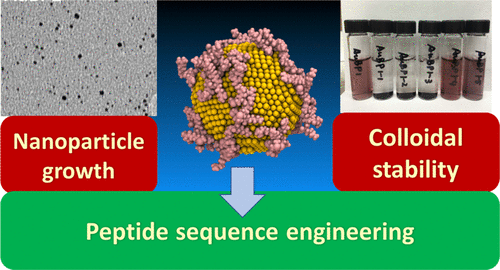当前位置:
X-MOL 学术
›
J. Phys. Chem. C
›
论文详情
Our official English website, www.x-mol.net, welcomes your feedback! (Note: you will need to create a separate account there.)
Peptide-Mediated Growth and Dispersion of Au Nanoparticles in Water via Sequence Engineering
The Journal of Physical Chemistry C ( IF 3.7 ) Pub Date : 2018-05-03 00:00:00 , DOI: 10.1021/acs.jpcc.8b02392 Michelle A. Nguyen 1 , Zak E. Hughes 2 , Yang Liu 3 , Yue Li 3 , Mark T. Swihart 3 , Marc R. Knecht 1 , Tiffany R. Walsh 2
The Journal of Physical Chemistry C ( IF 3.7 ) Pub Date : 2018-05-03 00:00:00 , DOI: 10.1021/acs.jpcc.8b02392 Michelle A. Nguyen 1 , Zak E. Hughes 2 , Yang Liu 3 , Yue Li 3 , Mark T. Swihart 3 , Marc R. Knecht 1 , Tiffany R. Walsh 2
Affiliation

|
The use of peptides to nucleate, grow, and stabilize nanoparticles in aqueous media via noncovalent interactions offers new possibilities for creating functional, water-dispersed inorganic/organic hybrid materials, particularly for Au nanoparticles. Numerous previous studies have identified peptide sequences that both possess a strong binding affinity for Au surfaces and are capable of supporting nanoparticle growth in water. However, recent studies have shown that not all such peptide sequences can produce stable dispersions of these nanoparticles. Here, via integrated experiments and molecular modeling, we provide new insights into the many factors that influence Au nanoparticle growth and stabilization in aqueous media. We define colloidal stability by the absence of visible precipitation at least 24 h after synthesis. We use binding affinity measurements, nanoparticle synthesis, characterization and stabilization assays, and molecular modeling to investigate a set of sequences based on two known peptides with a strong affinity for Au. This set of biomolecules is designed to probe specific sequence and context effects using both point mutations and global reorganization of the peptides. Our data confirm, for a broader range of sequences, that Au nanoparticle/peptide binding affinity alone is not predictive of peptide-mediated colloidal stability. By comparing nanoparticle stabilization assay outcomes with molecular simulations, we establish a correlation between the colloidal stability of the Au nanoparticles and the degree of conformational diversity in the surface-adsorbed peptides. Our findings suggest future routes to engineer peptide sequences for biobased growth and dispersion of functional nanoparticles in aqueous media.
中文翻译:

肽介导的序列工程介导的金纳米粒子在水中的生长和分散
通过非共价相互作用使用肽在水性介质中成核,生长和稳定纳米颗粒,为创建功能性,水分散性无机/有机杂化材料提供了新的可能性,特别是对于Au纳米颗粒。许多先前的研究已经鉴定出了既具有对Au表面的强结合亲和力又能够支持水中纳米粒子生长的肽序列。但是,最近的研究表明,并非所有此类肽序列都能产生这些纳米颗粒的稳定分散体。在这里,通过集成实验和分子建模,我们为影响金纳米颗粒在水性介质中生长和稳定的许多因素提供了新见解。我们通过合成后至少24小时内没有可见的沉淀来定义胶体稳定性。我们使用结合亲和力测量,纳米粒子合成,表征和稳定化验,以及分子建模来研究基于两个已知的对金具有强烈亲和力的肽的序列集。这套生物分子被设计为使用点突变和肽的整体重组来探测特定的序列和环境效应。我们的数据证实,对于更大范围的序列,单独的Au纳米颗粒/肽结合亲和力不能预测肽介导的胶体稳定性。通过比较纳米颗粒稳定化验结果与分子模拟,我们建立了金纳米颗粒的胶体稳定性与表面吸附肽的构象多样性程度之间的相关性。
更新日期:2018-05-03
中文翻译:

肽介导的序列工程介导的金纳米粒子在水中的生长和分散
通过非共价相互作用使用肽在水性介质中成核,生长和稳定纳米颗粒,为创建功能性,水分散性无机/有机杂化材料提供了新的可能性,特别是对于Au纳米颗粒。许多先前的研究已经鉴定出了既具有对Au表面的强结合亲和力又能够支持水中纳米粒子生长的肽序列。但是,最近的研究表明,并非所有此类肽序列都能产生这些纳米颗粒的稳定分散体。在这里,通过集成实验和分子建模,我们为影响金纳米颗粒在水性介质中生长和稳定的许多因素提供了新见解。我们通过合成后至少24小时内没有可见的沉淀来定义胶体稳定性。我们使用结合亲和力测量,纳米粒子合成,表征和稳定化验,以及分子建模来研究基于两个已知的对金具有强烈亲和力的肽的序列集。这套生物分子被设计为使用点突变和肽的整体重组来探测特定的序列和环境效应。我们的数据证实,对于更大范围的序列,单独的Au纳米颗粒/肽结合亲和力不能预测肽介导的胶体稳定性。通过比较纳米颗粒稳定化验结果与分子模拟,我们建立了金纳米颗粒的胶体稳定性与表面吸附肽的构象多样性程度之间的相关性。



























 京公网安备 11010802027423号
京公网安备 11010802027423号